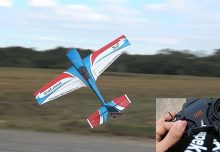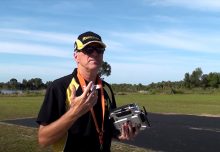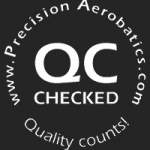The following are the best tips I have compiled from many sources and contributors. Many of these did not come directly from me, and I chose them for my list.
#1 Practice:
There is 3 things involved in flying. Seeing, interpreting what we see, and stick action; Eyes – Brain – Fingers. Practice can improve any of these aspects. 3D is particularly demanding on orientation; the bridge between the eyes and the fingers. The best tricks bypass the brain interpretation and become automatic. At this point, I believe most movements for me are automatic, and are a direct result of practice.
#2 Land keeping plane pointed at yourself until late:
When Landing on final, point the nose of the plane directly at yourself until you get a short distance before the runway begins. It is easy to just make a slight left or right adjustment to find runway center. This is a remarkably good tip that solved landing issues countless times as I trained pilots. Trying to line up straight from a long approach confuses your eye because of perspective issues. Your eye is confused at the plane’s actual direction. This is why so many just keep missing the runway. Also, Improve the softness of your landings by looking at the wheels instead of the plane as a whole in the last moments of the landings.
#3 Take off with Speed:
With warbirds and Jets especially, do not take off without plenty of speed… Especially on a maiden flight. Stay on the runway as long as possible. Biggest cause of crashes is lifting off early with scale planes where the initial speed loss of ascent or sharp ascent causes a tip stall. At this point, you are so slow all flight controls get very mushy and ineffective. Then it is not possible to recover. An overpowered plane eliminates this, but many scale planes can be very susceptible to this. It is easy to lift off accidentally as well. The extra speed is a necessary safety step.
#4 Elevator for speed and throttle for altitude:
While landing, the elevator should be used for AOA and airspeed, while the throttle should be used strategically for controlling for altitude during landing. Since you want to stall the plane near the ground to land and not bounce down the runway, you need to be slow. All full-scale planes land this way. They land with power on. The biggest and most common mistake I see is just coasting to the ground and landing too fast. Then the plane bounces and lifts off again and causes all kind of problems. Land slower by slowing down a lot and then adding a bit of power back. Again, full-scale planes do it this way.
#5 Sticks together or sticks apart for knife edge
To enter Knife edge flight from level flight move rudder/ aileron sticks in opposite direction Sticks or Same direction (aileron slightly before rudder). When rolling right, move the sticks apart and this will have rudder in correct direction. When rolling left, move the sticks together. Of course when doing from inverted, left and right are opposite. Also, another tip is if you’re seeing the canopy move rudder stick to the tail, and if you’re seeing the belly then move it towards the motor.
#6 When control is lost. Keep flying the plane.
When in a crisis, don’t panic. Keep flying the plane. So you’re about to go down while trying a move close to the ground or at altitude. Don’t immediately panic and give full throttle to (hopefully) pull out or just give up. Get the plane under control first then add an appropriate amount of throttle. Sometimes you’ll crash it anyway, though. But hey, at least you tried.
#7 Power into turns when slow or on approach
Power into turns while making final turns for landing when going slow. Many warbird or jet crashes happen flying slow on the corners. The turn simply slows the slow flying plane even more, and the banked wings alters lift. The plane tip stalls, then your ailerons and elevator fail to do anything. It often feels like you lost radio signal, but you didn’t. Every club I go to, someone will come up to me and say “there is a mysterious dead zone in the corners” I generally laugh to myself knowing they have witnessed what I discussed repeatedly.
#8 Power for altitude in knife-edge flight
knife-edge flight is pretty easy to master. Getting low seems to be a universal problem until you know and understand this tip. Use the rudder only to establish angle of attack. And get the nose level or pointing upward. Then, reduce the power and the plane will descend. When you get low enough, just add throttle. Do not change the rudder. Although in truth, you may be adjusting rudder all the time, the principal is that power alone will be responsible for altitude. Early in my career, this gave me a real headache and I just couldn’t get it. Then I discovered this on my own. I could have mastered in one day what took 3 months.
#9 When hovering belly in move rudder in direction of falling wing.
When hovering with the belly facing you, or in the 180 degree point of a torque roll, if the wing drops in one direction or the other, use the rudder direction to lift that wing to level. In other words, think of the rudder as lifting the falling wing back up (because that is what it is doing). PUSH THE RUDDER STICK IN THE DIRECTION OF THE FALLING WING.
#10 When inverted, push the end toward in direction you want to go or move rudder to pointy end.
When flying inverted, it is best to imagine the plane being a disk, and the rudder will turn which ever pointy end (nose, tail, or either wing tip) is closest to you in the direction you move the stick. Whatever part of the plane you’re looking at, use the stick to “push” that part of the plane in the direction you want it to go.
For instance: If you’re inverted coming towards yourself, if you want the plane to make a turn to your right you push the rudder right, and that’ll push the nose to the right relative to you.
Likewise if the plane is heading away from you, and you want the plane to go to your right, you’ll “push” the tail to the left, so rudder stick left, and that’ll push the tail to the left and the plane will turn right, relative to you.
PLUS 1 Bonus tip) Trim and mix for knife-edge flight:
When flying normally we all trim our airplanes by adding a bit of elevator, rudder or aileron to make it fly straight hands off. One of the absolute dumbest advice I see as rampant throughout the flying world is to fly through knife edge without trimming. This is absolutely ridiculous. Would you ever fly a plane perpetually without trimming it and fighting just to stay level or stop rolling without input? Absolutely not! No one would. Then why when you go knife edge would that be acceptable. Use rudder/elevator or rudder/aileron mixing to trim it to fly straight. Most good aerobatic planes are pretty close with no mixing, but a Cessna or biplane, you absolutely need it. A lot of things affect it, but once you trim it for knife edge and mix out the coupling issues, flying knife edge is much easier and you still make adjustments for wind and so on as you would in any other situation. Another important thing to keep in mind that when you roll the plane, if it is not mixed and trimmed for knife edge, it will not roll straight. If you perform a 4-point roll, it will not end up straight. In level flight it will, but when it goes on knife edge, it will push or pull with the bad tendencies if not adjusted. Rolling harriers and all slow rolls get really ugly as well if not mixed out. (I have a mixing guide available to instruct you on mixing)
Other Good Tips
- To learn to harrier, perfect the “elevator” maneuver, then add throttle. The elevator is an easy, safe maneuver. Transitioning to harrier is easy.
- Perfecting the Vortex maneuver.
1) Fly a level knife edge at a slow cruising speed, maybe half throttle or so.
2) If you are flying from right to left in front of you, you will have a specific amount of right rudder to hold level flight. In this example let’s say you are using 1/3 right rudder to hold a level knife edge.
3) When the plane gets directly in from of you begin the Vortex. Simply apply full down elevator and 1/3 left rudder. The plane will tumble tightly in knife edge and as it passes 180 degrees or so of rotation immediately reverse the rudder back to 1/3 right rudder and neutralize the elevator at 360 degrees again and continue flying off in knife edge flight.
This is a fairly easy maneuver to get comfortable with and is easy to do in any KE flight path, right, left, climbing or descending. The key component is just switching the rudder from one side to the other and back with full down elevator. It also works for tight KE snap turns for 90 degrees, 180, or the full 360. It can be done without reversing the rudder (just neutralizing it) if down elevator is applied when the fuselage is level but the rudder reversal thing really helps prevent the vortex from becoming a waterfall. I sort of stumbled onto this by accident, saw that it worked, and stuck with it. It is a nice maneuver and can be used in all kinds of transitions.
- Wing rock in harrier Cure: Increase angle of attack and check C.O.G.
- Harrier landings:
The key is AOA and throttle for a smooth decent (elevator) to about 1 foot and then a smooth increase power with a slow release of the elevator. The increase in power is so you don’t plop but move forward as you release the elevator.
- P-factor compensation:
Typically up-elevator moves are already P-factor compensated with built-in right thrust. But hard down-elevator / high throttle pushes like avalanches will have big P-factor the other way (since the plane is sloshing high alpha upside-down), and needs left rudder during the momentum fall and definitely as you pump throttle. Similarly, holding a straight inverted harrier needs left rudder pressure, more or less proportional to throttle as you harrier around.
Knowing that you need left rudder in inverted high alpha can help diagnose those weird days when those moves don’t feel right.
- Hover closer to yourself to perfect. It is much easier to see and react to your corrections.
- Do 4 point rolls around the field and/or very slow rolls to help get rolling harriers.
- Watch the nose on rolling harriers.
- Throttle for altitude for Knife edge.
- When hovering, don’t focus on keeping the plane from falling, focus on keeping it from rising.
- Perfect the COG. This is a universal cure for most of what ails an airplane not flying well.
- To find the COG, put the plane on a 45 degree climb at 2/3 throttle while inverted. The plane should make a very slow arc toward the ground. It should not climb or move obviously toward the ground. If it goes nose up, it is tail heavy. If it noses toward the ground, it is nose heavy.







